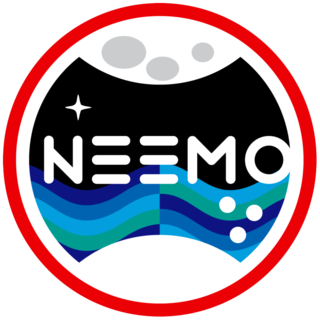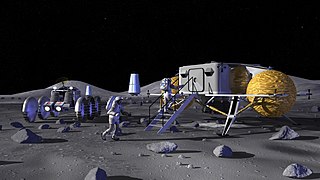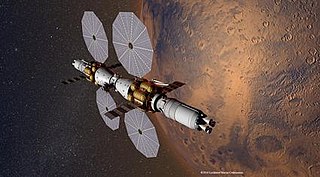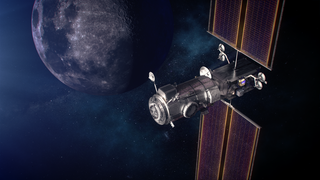
Space colonization is the hypothetical permanent settlement and exploitation of natural resources at celestial objects other than Earth. As such it is a form of human presence in space, beyond human spaceflight and operating space outposts.

A space station is a spacecraft capable of supporting a human crew in orbit for an extended period of time, and is therefore a type of space habitat. It lacks major propulsion or landing systems. An orbital station or an orbital space station is an artificial satellite. Stations must have docking ports to allow other spacecraft to dock to transfer crew and supplies. The purpose of maintaining an orbital outpost varies depending on the program. Space stations have most often been launched for scientific purposes, but military launches have also occurred.

A space habitat is a more advanced form of living quarters than a space station or habitation module, in that it is intended as a permanent settlement or green habitat rather than as a simple way-station or other specialized facility. No space habitat has been constructed yet, but many design concepts, with varying degrees of realism, have come both from engineers and from science-fiction authors.

Steven Weldon Squyres is an American astronomer and planetary scientist. He was the James A. Weeks Professor of Physical Sciences at Cornell University in Ithaca, New York. His research area is in planetary sciences, with a focus on large solid bodies in the Solar System such as the terrestrial planets and the moons of the Jovian planets. Squyres was the principal investigator of the Mars Exploration Rover Mission (MER).

Colonization of the Moon is a process, or concept employed by some proposals, for claiming robotic or human exploitation and settlement on the Moon.

The Aquarius Reef Base is an underwater habitat located 5.4 miles off Key Largo in the Florida Keys National Marine Sanctuary. It is deployed on the ocean floor 62 feet below the surface and next to a deep coral reef named Conch Reef.

Underwater habitats are underwater structures in which people can live for extended periods and carry out most of the basic human functions of a 24-hour day, such as working, resting, eating, attending to personal hygiene, and sleeping. In this context, 'habitat' is generally used in a narrow sense to mean the interior and immediate exterior of the structure and its fixtures, but not its surrounding marine environment. Most early underwater habitats lacked regenerative systems for air, water, food, electricity, and other resources. However, some underwater habitats allow for these resources to be delivered using pipes, or generated within the habitat, rather than manually delivered.

Colonization or settlement of Mars is the human migration and long-term establishment on Mars. It has received interest from public space agencies and private corporations, and been extensively explored in science fiction writing, film, and art.
Dennis Chamberland is an American bioengineer, explorer, and author.

NEEMO, an acronym for NASA Extreme Environment Mission Operations, is a NASA analog mission that sends groups of astronauts, engineers and scientists to live in Aquarius underwater laboratory, the world's only undersea research station, for up to three weeks at a time in preparation for future space exploration.

In space exploration, in situ resource utilization (ISRU) is the practice of collection, processing, storing and use of materials found or manufactured on other astronomical objects that replace materials that would otherwise be brought from Earth.

The following outline is provided as an overview of and topical guide to space exploration.

NASA has made many concepts of moonbases for achieving a permanent presence of humans on the Moon. The American government agency requested an increase in the 2020 budget of $1.6 billion, in order to make another crewed mission to the Moon by 2025, followed by a sustained presence on the Moon by 2028.

Space architecture is the theory and practice of designing and building inhabited environments in outer space. This mission statement for space architecture was developed at the World Space Congress in Houston in 2002 by members of the Technical Aerospace Architecture Subcommittee of the American Institute of Aeronautics and Astronautics (AIAA). The architectural approach to spacecraft design addresses the total built environment. It is mainly based on the field of engineering, but also involves diverse disciplines such as physiology, psychology, and sociology.
Human analog missions are activities undertaken on Earth in various environments to simulate aspects of human missions to other worlds, including the Moon, asteroids, and Mars. These remote field tests are performed in locations that are identified based on their physical similarities to the extreme space environments of a target mission. Such activities are undertaken to test hardware and operational concepts in relevant environments.

Jonathan Robert Dory is a Human Systems Integration Lead at NASA's Johnson Space Center (JSC) in Houston, Texas. He is Branch Chief of NASA's Habitability and Human Factors Branch, part of the Habitability and Environmental Factors Division at NASA/JSC. Dory supports crew safety and productivity on the International Space Station (ISS) Program by planning and assessing the on-orbit interior configuration of ISS, as well as performing anthropometric analysis of crew tasks. He contributes to the integrated operation of the Space Station while using 3D computer graphics and animation software as part of his daily work. In July 2002, Dory served as an aquanaut on the NASA Extreme Environment Mission Operations 3 crew.
Terrestrial analogue sites are places on Earth with assumed past or present geological, environmental or biological conditions of a celestial body such as the Moon or Mars. Analogue sites are used in the frame of space exploration to either study geological or biological processes observed on other planets, or to prepare astronauts for surface extra-vehicular activity.

A Mars habitat is an hypothetical place where humans could live on Mars. Mars habitats would have to contend with surface conditions that include almost no oxygen in the air, extreme cold, low pressure, and high radiation. Alternatively, the habitat might be placed underground, which helps solve some problems but creates new difficulties.

Mars Base Camp (MBC) is a crewed Mars laboratory orbiter concept under study that was commissioned by NASA from Lockheed Martin in US. It would use both future and proven concepts as well as the Orion MPCV, also built by Lockheed Martin.

The Lunar Gateway, or simply Gateway, is a planned small space station in lunar orbit intended to serve as a solar-powered communication hub, science laboratory, short-term habitation module for government-agency astronauts, as well as a holding area for rovers and other robots. It is a multinational collaborative project involving four of the International Space Station partner agencies: NASA, European Space Agency (ESA), Japan Aerospace Exploration Agency (JAXA), and Canadian Space Agency (CSA). It is planned to be both the first space station beyond low Earth orbit and the first space station to orbit the Moon.
















